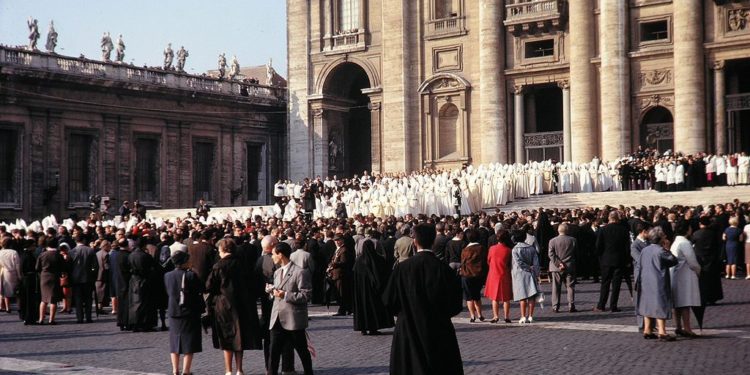Ahead of the council, then Bishop Wojtyla submitted to council organizers an essay about the human condition in which he reflected on what the people of the world expect from the Church.
He emphasized lay Catholics’ mission in the world. For John Paul II, the Church should remind lay Catholics that they have a “specific responsibility” in secular life, where they are “responsible for the Church and its witness.” They and the clergy must make a mutual effort to build up the Body of Christ.
The Pole’s biography on the Vatican website notes his “important contribution” to drafting Gaudium et Spes, the council’s pastoral constitution on the Church in the modern world.
One of John Paul II’s biographers, George Weigel, says that for Wojtyla the “theological linchpin” of the council is found in Gaudium et Spes’ 20-second paragraph: “It is only in the mystery of the Word made flesh that the mystery of man truly becomes clear… all this holds true not just for Christians only, but also for all men of goodwill in whose hearts grace is actively present.”
During Wojtlya’s trips back home, he gave public lectures on what was happening at the council. He asked parishes, convents, and monasteries in his home archdiocese to hold days of prayer and vigils for the council, Weigel says in his biography “Witness to Hope.”
The council’s declaration on religious freedom, Dignitatis Humanae, had special resonance for Wojtyla, whose homeland suffered heavy communist hostility toward the Church.
A shared vision: Benedict XVI and John Paul II find continuity amid renewal
Especially in North America and western Europe, many news reports, religion commentators, and academics promoted and praised the Second Vatican Council as a major break in Church history. Most of these critics came from a “liberalizing” or “secularizing” perspective, though some vocal “traditionalist” Catholics believed similarly.
Both John Paul II and Benedict XVI took pains to set the record straight.
We see this in John Paul II’s Feb. 27, 2000, address.
The sainted pope said the council’s teaching “requires ever deeper understanding,” but in an authentic way. A true understanding must overcome “biased and partial interpretations which have prevented the newness of the council’s Magisterium from being expressed as well as possible.”
(Story continues below)
The correct interpretation of Catholic dogma or an ecumenical council must come from “within the fabric of faith and not outside it,” he said.
“To interpret the council on the supposition that it marks a break with the past, when in reality it stands in continuity with the faith of all times, is a definite mistake,” Pope John Paul II said. “What has been believed by ‘everyone, always and everywhere’ is the authentic newness that enables every era to perceive the light that comes from the word of God’s Revelation in Jesus Christ.”
Benedict XVI echoed his predecessor in February 2013, just weeks before his pontificate ended.
“The world interpreted the council through the eyes of the media instead of seeing the true council of the fathers and their key vision of faith,” he said in a Feb. 14 address.
“The media saw the council as a political struggle, a struggle for power between different currents within the Church,” he recalled. “But it was obvious that the media would take the side of whatever faction best suited their world.”
This phenomenon obscured the council’s teaching on the true role of the Church, the pope, the Catholic bishops, and the laity. Coverage of changes in the Catholic liturgy avoided presenting the Mass as an act of faith but rather presented it as a “community activity.”
Credit: Source link




